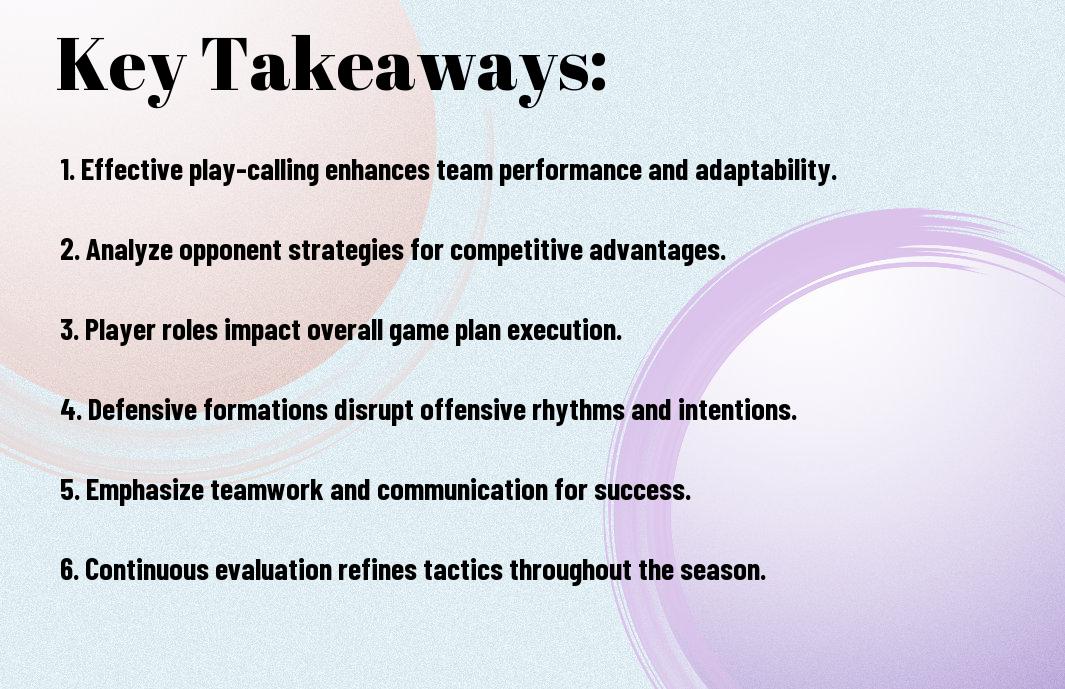As you examine into the world of football betting, you’ll discover various systems designed to help you make informed decisions. Your goal is to increase your chances of winning, and with the right strategies, you can achieve this. You’ll learn how to analyze teams, identify patterns, and make smart bets. By understanding these systems, you’ll be able to develop your own approach, tailored to your betting style and preferences, and improve your overall betting experience.
Key Takeaways:
- Understanding the different types of football bets, such as point spreads, moneylines, and over/unders, is important for developing effective betting strategies.
- Analyzing team and player performance, including statistics and trends, can help inform betting decisions and increase the chances of winning.
- Managing bankroll and setting realistic expectations are vital components of a successful football betting system, as they help mitigate risk and avoid significant financial losses.
- Staying up-to-date with injury reports, weather conditions, and other factors that can impact game outcomes can provide a competitive edge in making informed betting decisions.
- Discipline and patience are key to long-term success in football betting, as impulsive decisions based on emotions or hunches can lead to costly mistakes and significant losses.
Basic Football Betting Fundamentals
The foundation of successful football betting lies in understanding the basics. You can start by learning from established systems, such as the Seven Successful NFL Week 1 Betting Systems, to inform your strategy.
Point Spreads and Money Lines
At the heart of football betting are point spreads and money lines, which you’ll need to grasp to make informed wagers, considering factors like team performance and odds.
Over/Under Betting Options
Money management is key when exploring over/under betting options, where you predict the total score, and you should consider the teams’ offensive and defensive strengths.
Another aspect of over/under betting options is understanding how external factors, such as weather conditions and injuries, can impact the total score, allowing you to make more accurate predictions and potentially increase your winnings, as you navigate the world of football betting with confidence and strategy.
Statistical Analysis Approach
You will find that a statistical analysis approach is a key component of successful football betting systems, as it enables you to make informed decisions based on data and trends, rather than relying on intuition or guesswork, and this approach can be applied to various aspects of the game, including team performance and historical data.
Team Performance Metrics
After gathering data on team performance, you can analyze metrics such as possession, shots on goal, and passing accuracy to gain a deeper understanding of a team’s strengths and weaknesses, and this information can be used to inform your betting decisions and develop a winning strategy.
Historical Data Evaluation
Before placing a bet, you should evaluate historical data to identify trends and patterns that can inform your decision, and this includes analyzing past performances, head-to-head matchups, and other relevant data points that can help you make a more informed decision.
Consequently, by carefully evaluating historical data, you can develop a more nuanced understanding of the teams and players involved, and make more accurate predictions about the outcome of a game, which can ultimately lead to more successful betting outcomes and a higher return on your investment, and you can use this information to refine your strategy and make adjustments as needed.

Weather Impact Strategy
Not many factors can influence the outcome of a football game as much as the weather. You need to consider how different conditions can affect your betting strategy, as they can significantly impact the gameplay and your potential winnings.
Climate Conditions Assessment
By evaluating the climate conditions of the location where the game is being played, you can make more informed decisions about your bets. You should consider factors such as temperature, humidity, and wind, as they can affect the players’ performance and the overall game dynamics.
Stadium-Specific Factors
Against the backdrop of varying stadium conditions, you should consider the following factors when placing your bets:
- Altitude
- Turf type
- Stadium size
Assume that understanding these factors will help you make more accurate predictions and increase your chances of winning.
At the heart of your weather impact strategy, stadium-specific factors play a significant role. You should consider the following factors when evaluating a stadium:
- Weather patterns
- Stadium design
- Field conditions
Assume that taking these factors into account will help you develop a more effective betting strategy and increase your potential winnings.
Player-Based Betting Systems
Your approach to football betting can be greatly enhanced by focusing on individual players, as their performance can significantly influence the outcome of a match.
Key Position Analysis
Against the backdrop of team dynamics, analyzing key positions such as goalkeepers, defenders, and forwards can help you make informed betting decisions, taking into account their strengths and weaknesses.
Injury Impact Calculations
Across various teams and matches, you will encounter situations where player injuries affect the betting odds, and understanding how to calculate the impact of these injuries on your bets is imperative for success.
Impact of injuries on a team’s performance is something you should consider when placing bets, as it can lead to changes in strategy, player substitutions, and overall team morale, all of which can affect the outcome of the match and, consequently, your betting decisions.
Bankroll Management
Now that you’re familiar with the basics of football betting, it’s time to focus on managing your bankroll. This involves setting a budget and sticking to it, to avoid significant financial losses. You need to determine how much you can afford to bet and how to allocate your funds effectively.
Risk Assessment Methods
Behind every successful betting strategy lies a thorough risk assessment. You will need to evaluate the potential risks and rewards of each bet, considering factors such as the teams’ performance, odds, and other relevant data to make informed decisions.
Staking Plan Structure
Behind a well-structured staking plan is a clear understanding of your betting goals and risk tolerance. You should consider developing a plan that outlines how much to bet on each game, taking into account your overall budget and the potential outcomes.
A key aspect of a staking plan structure is determining the optimal bet size for each game. You will need to balance the potential returns with the risk of losing, ensuring that your bets are consistent with your overall strategy and budget. As you develop your staking plan, you should consider factors such as the strength of your picks, the odds, and the potential payout, to maximize your chances of success.

Live Betting Tactics
Once again, you’ll need to adapt your strategy when betting live, as the dynamics of the game can change rapidly. You’ll have to make quick decisions based on the current state of the game, taking into account factors like score, injuries, and momentum shifts.
In-Game Momentum Shifts
Prior to making any live bets, you should consider the momentum of the game, as it can greatly impact the outcome. You’ll want to assess how the teams are performing and adjust your bets accordingly, taking into account any changes in the game’s momentum.
Real-Time Odds Adjustments
By monitoring the game’s progression, you can identify opportunities to adjust your bets in real-time, as the odds will fluctuate based on the current state of the game. You should be prepared to act quickly to take advantage of favorable odds.
With real-time odds adjustments, you can capitalize on shifts in the game, such as a team scoring or a key player getting injured. You’ll need to stay focused and react swiftly to changing circumstances, using your knowledge of the game to inform your betting decisions and maximize your chances of winning.
Summing up
Upon reflecting on football betting systems, you now have a solid foundation to develop your own strategies for the field. You can analyze your betting style and adapt techniques to suit your needs. With your newfound knowledge, you can make informed decisions and improve your chances of success. Your understanding of the systems will help you navigate the field with confidence, allowing you to refine your approach and achieve your betting goals.
FAQ
Q: What are the most popular football betting systems used by experienced bettors?
A: There are several popular football betting systems used by experienced bettors, including the Martingale system, the Fibonacci system, and the Kelly Criterion. The Martingale system involves doubling the bet after each loss, while the Fibonacci system involves increasing the bet by a predetermined amount after each loss. The Kelly Criterion, on the other hand, involves betting a fraction of the bankroll that is proportional to the perceived edge. Each system has its own advantages and disadvantages, and bettors should carefully consider their options before choosing a system to use.
Q: How can I develop a successful football betting strategy for the field?
A: Developing a successful football betting strategy for the field involves a combination of research, analysis, and discipline. First, it’s necessary to have a thorough understanding of the game, including the teams, players, and coaches. Next, bettors should analyze statistics, trends, and other data to identify potential advantages and disadvantages. It’s also important to set a budget and stick to it, as well as to avoid making emotional decisions based on personal biases or recent results. Additionally, bettors should consider using a combination of betting systems and strategies, such as hedging and line shopping, to maximize their chances of success.
Q: What are some common mistakes to avoid when using football betting systems and strategies?
A: There are several common mistakes to avoid when using football betting systems and strategies, including chasing losses, betting on too many games, and failing to manage the bankroll. Chasing losses involves increasing the bet size in an attempt to recoup previous losses, which can lead to a rapid depletion of the bankroll. Betting on too many games can also be problematic, as it increases the risk of losing and makes it more difficult to manage the bankroll. Finally, failing to manage the bankroll can lead to financial difficulties and a lack of discipline, which can negatively impact the overall betting experience. By avoiding these common mistakes, bettors can increase their chances of success and enjoy a more profitable and enjoyable betting experience.






